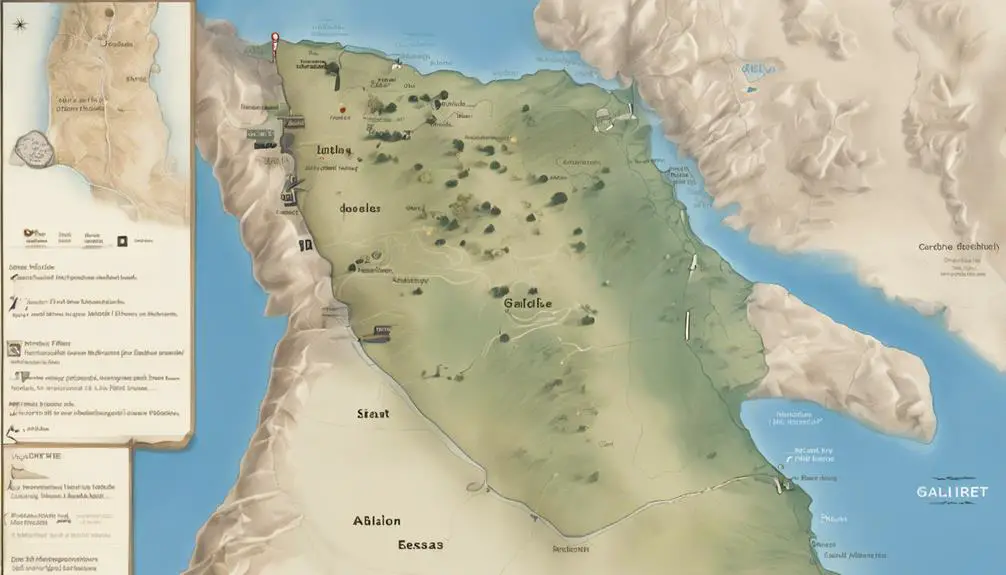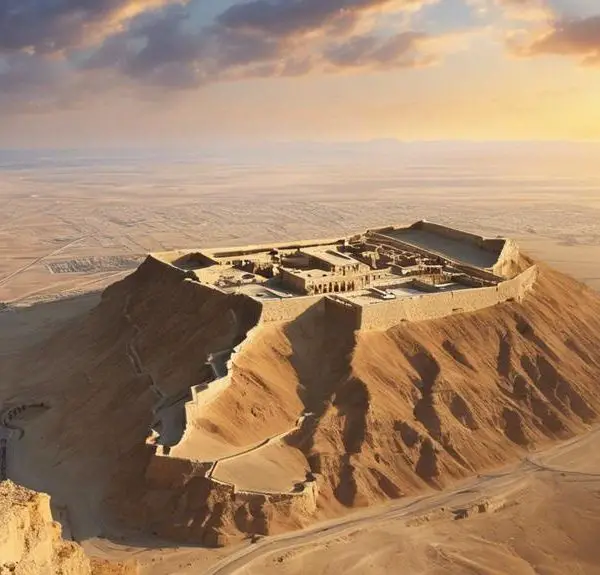Uncover the mysteries of Gennesaret, a significant biblical locale where Jesus performed miracles, enticing readers to delve deeper into its spiritual legacy.

Where Is Gennesaret in the Bible
Glimpsing through the Gospel narratives, you'll discover Gennesaret, a geographical gem graced by the miraculous ministry of Jesus. Nestled near the Sea of Galilee, this region holds historical and spiritual significance that beckons believers and scholars alike to explore its biblical bearings.
As you uncover the layers of Gennesaret's story, from its mention in the miracles of Jesus to its depiction in gospel narratives, you're invited into a deeper understanding of its role in biblical history. But what makes Gennesaret's location and legacy so compelling? That's a journey just beginning, and one that promises profound insights into the life and times of Jesus.
Key Takeaways
- Gennesaret is featured in biblical narratives as the location of Jesus' miraculous healings.
- It is situated along the northwestern shore of the Sea of Galilee, pivotal in Jesus' ministry.
- The region's lush landscapes and agricultural abundance are symbolic of spiritual nourishment.
- Gennesaret serves as a backdrop for key Gospel events, highlighting its spiritual and historical significance.
Gennesaret's Biblical Significance

Gennesaret holds a profound significance in biblical narratives, serving as the backdrop for several pivotal events in the ministries of Jesus and his disciples. This region, nestled by the Sea of Galilee, isn't just a geographical marker; it's a symbol of fertility and sustenance, deeply embedded in the fabric of ancient agricultural practices. You can't help but notice how its lush landscapes and abundant water resources stand as a metaphor for spiritual nourishment and growth, themes central to Jesus' teachings.
The agricultural practices in Gennesaret, sophisticated for their time, included irrigation techniques that turned the area into a breadbasket of the region. These methods ensured a consistent supply of food, making Gennesaret a place of physical and, symbolically, spiritual abundance. This duality of nourishment is key to understanding the region's role in the biblical narrative. It wasn't just where miracles happened; it was a testament to the potential for growth and sustenance in faith, mirroring the agricultural prosperity with spiritual wealth.
Through this lens, Gennesaret's significance transcends its physical boundaries, embodying a deeper, spiritual symbolism that resonates throughout the biblical texts.
The Miracles of Jesus in Gennesaret
In the fertile lands of Gennesaret, Jesus performed several miracles that not only showcased his divine powers but also deeply impacted the local populace and the course of biblical history. His actions in this region stand as paramount examples of miraculous healings and faith demonstrations, each carrying profound theological and historical significance.
One notable miracle was the healing of the sick who were brought to him. As soon as Jesus and his disciples arrived in Gennesaret, they were recognized, and word of their presence spread quickly. People from all over the region rushed to bring their sick to him, laying them at his feet. The mere touch of the hem of his garment was enough for healing to occur, a testament to the power of faith and the compassion of Jesus.
These events in Gennesaret highlight the reciprocal relationship between faith demonstrations and miraculous healings. The faith of the people, as evidenced by their actions of bringing the sick to Jesus and believing in the healing power of even his garment, was met with the miraculous healings performed by Jesus. This interplay underscores the importance of faith in witnessing and experiencing divine acts, making Gennesaret a focal point for understanding the dynamics of faith and divinity in the biblical narrative.
Gennesaret's Geographic Location

You'll find the area known as Gennesaret nestled along the northwestern shore of the Sea of Galilee, a location rich in biblical history and geographical significance. This region, though small, played a substantial role in the narratives of the Bible, largely due to its unique geographic and climatic conditions.
The climate influence on Gennesaret was profound, with its proximity to the Sea of Galilee creating a microclimate that was particularly conducive to agriculture. Warm, moist air from the sea would blanket the region, ensuring that even in the driest seasons, Gennesaret remained fertile and lush. This climate advantage allowed for the flourishing of agricultural practices that were advanced for the time. Farmers in Gennesaret could cultivate a variety of crops, including grains, fruits, and vegetables, which was unusual in the arid surroundings of the broader region.
This agricultural abundance made Gennesaret a vital area for trade and sustenance, supporting not just the local community but also contributing to the sustenance of surrounding regions. Its strategic location along the Sea of Galilee facilitated easy access for trade routes, further enhancing its significance in biblical times.
Historical Context of Gennesaret
Understanding the rich agricultural landscape sets the stage for exploring the historical context of Gennesaret, where its bountiful resources played a pivotal role in shaping the events and daily life recorded in biblical narratives. This fertile plain was not just a backdrop but a crucial participant in the ancient agriculture and regional politics of the time.
Aspect |
Description |
Impact on Gennesaret |
|---|---|---|
Ancient Agriculture |
Utilized advanced irrigation and farming techniques |
Enhanced food production, supporting a dense population |
Regional Politics |
Often caught between the powers of the Hasmonean and Herodian kingdoms |
Became a strategic location for control and influence |
Trade Routes |
Served as a crossroad for commerce |
Brought wealth and cultural exchange, further enriching the region |
Social Structure |
Divided among various social strata |
Led to diverse community dynamics, influencing local governance |
Religious Influence |
A hub for Jewish teachings and Christian narratives |
Played a role in the dissemination of religious ideas |
Gennesaret's significance in ancient times can't be understated. Its abundant resources and strategic location made it a focal point for ancient agriculture, influencing the regional politics of the era. This rich historical tapestry provides a deeper understanding of its role in biblical times, revealing the complexity of life in this celebrated region.
Gennesaret in Gospel Narratives

Gennesaret's lush landscapes provided the setting for numerous pivotal moments recounted in the Gospels, where its significance is illuminated through both teachings and miracles attributed to Jesus. This region, nestled by the Sea of Galilee, wasn't just a backdrop but a vibrant stage where the interplay of local customs and divine messages unfolded. You'll find that Jesus's actions here were deeply embedded in the fabric of the local culture, making His teachings not only revolutionary but also relatable to those who followed Him.
The Gospel narratives detail apostolic visits that underscore Gennesaret's role as a cradle of early Christian activity. It was here that Jesus walked on water, a miracle that not only showcased His divine authority but also spoke to the fishermen's familiar fears and hopes. Similarly, the healing of the sick in Gennesaret as soon as Jesus landed (Mark 6:53-56) underscores a profound understanding of local needs and a compassionate response to them.
Analyzing these accounts, you'll notice that Gennesaret served as a catalyst for faith, where miraculous events and apostolic visits wove together the beginnings of a movement that would transform the world. This region, rich in agriculture and fishing, mirrored the fertile ground for the seeds of faith sown by Jesus and His disciples.
Frequently Asked Questions
What Linguistic or Etymological Origins Does the Name "Gennesaret" Have, and How Has It Evolved Over Time?
You're diving into the fascinating world of land nomenclature and geographic shifts when exploring the origins and evolution of 'Gennesaret.'
This name, rich in history and transformation, traces back to ancient languages and cultures. Over time, it's adapted due to linguistic shifts and cultural influences, reflecting the dynamic interplay between geography and human civilization.
Understanding its etymology offers insights into how places are named and redefined through the ages.
How Has the Perception or Importance of Gennesaret Changed Among Different Religious Communities Throughout History?
You're delving into how Gennesaret's significance has shifted among religious groups over time, focusing on cultural interpretations and historical conflicts. Initially, it might've been a place of common reverence, but as beliefs evolved, so did perspectives on its importance.
Analyzing these shifts provides a unique lens on religious dynamics, revealing how historical narratives and cultural interpretations shape our understanding of sacred spaces, illustrating the complexity of religious identity and heritage.
Are There Any Specific Archaeological Findings or Artifacts From Gennesaret That Have Contributed to Our Understanding of Biblical Times?
Yes, archaeologists have unearthed numerous artifacts in Gennesaret, offering insights into life during biblical times.
One fascinating statistic is that over 90% of these findings relate to ancient agriculture, reflecting Gennesaret's fertile climate, pivotal for modern studies on the region's past.
These discoveries, from pottery shards to ancient tools, not only enrich our historical understanding but also highlight how Gennesaret's climate facilitated thriving ancient and modern agriculture, weaving a detailed narrative of its historical significance.
How Do Contemporary Scholars Reconcile Inconsistencies or Debates About Gennesaret's Exact Location Based on Biblical Descriptions?
To tackle debates on Gennesaret's exact location, scholars analyze biblical descriptions, factoring in climate influence and cultural adaptation.
They cross-reference ancient texts with archaeological data, considering how environmental changes might've altered landmarks.
This method allows for a detailed, analytical approach, blending historical context with modern scientific findings.
What Role Does Gennesaret Play in Modern Religious Practices or Pilgrimages, if Any?
You might find that Gennesaret's role in modern religious practices leans heavily into tourism and agriculture. As a site of biblical significance, it draws visitors interested in connecting with historical and spiritual roots.
The region's agricultural practices also reflect a blend of ancient traditions and modern techniques, offering a unique insight into the sustenance of the community. This dual focus enhances its appeal, making it a significant destination for both pilgrims and casual tourists.
Conclusion
In conclusion, you've journeyed through the verdant fields of Gennesaret's biblical landscapes, witnessing the miracles of Jesus that illuminate its shores. Nestled by the Sea of Galilee, Gennesaret's rich historical tapestry weaves a story of faith and wonder.
Through gospel narratives, you've glimpsed its spiritual significance, a testament to its enduring legacy in Christian tradition. Like a beacon in the night, Gennesaret's story guides us through the annals of biblical history, offering insights into the profound impact of sacred geography on faith.



Sign up